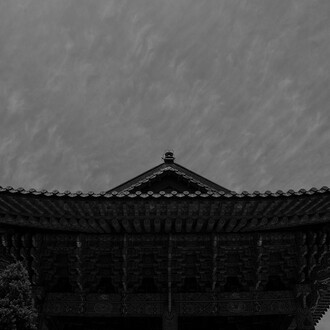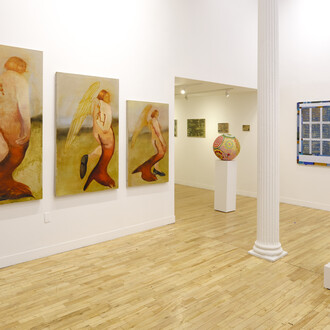Heizle’s work engages in a good deal of “worldmaking”, such that the project is appropriately called “Hazeland”. In this “land”, one far from the annals of everyday, prismatic skeins and trickles of aquamarine, cyan, and pink float into droplet-rivulets that pour down an oceanic arcade. These are alien oceans, beyond the picturesque.
The ocean and her tides all look a bit abstract at first glance—that is until one notices that her skeins furl into the shape of seashells, pooling into a cascade of finely pronounced rigged semicircles. In the bottom right of one such canvas, tortuous black tentacles reach, lapping up the miasma of prismatic rills and runnels. The work, then, is not truly abstraction—or at least not “non-objective” abstraction—as this “land”, where one floats on violaceous waves, is populated by amoebic sea forms and the winding rolls of their roll and lull.
Trekking the earth, we come upon further expanses in this land that flutter with the light beat of butterfly wings. These butterflies and their kindred fauna are posited over a similar palette to the “ocean world”: blush fuchsia, roseate pink, and thin daffodil yellows. This parcel of land is equally serene and fitted with the decorative, ethereality sundered and dissolved into a candy-sweet artifact. The canvas feels bisected, one half devoted to a background threading smudges of plum-purple smearing and the other half, the foreground, writhing with insects drafted in outline. The butterfly is a recurrent motif for the artist, present in each of the pieces.
In one of the most interesting works, the background is overtaken by overcast, nebulous branches darted with white stipples; the air feels icy and shrill as if we are bearing witness to a winter eve kissed by snowfall. The centerpiece here is a silver butterfly preserved in a heart-like frosted sack. This suspended glowing sack, evocative of a heaving slug gasping for oxygen, finds its organic tunnels burrowed by the dun of shadowy branches. In yet another work that references the previous gambit of motifs, the heart is turned into an ornamental crux, a crown jewel. The interior frame features undulating butterflies, now dotting each corner, the palette- turquoise riven with a glowing peach-pink orb. It is the palette and the cast of motifs that carry us from work to work, a fabric stitching each element to a contained set.
Much glows in Hazeland. The glow is an inescapable rhythm, a drumbeat that matches those refracted rainbow rays of slick summer oil oft pooling on the sidewalk and revealing kaleidoscopic brilliance when prodded by the sun. Plumes of yellow-gold and green-blue cast the sky, trapped globules marking their descent. The artist has taken to the organic, as their use of the heart strays from that cartoonish motif of the crimson, balloon-lipped heart of cartoons and popular imagery. In Hazeland, the heart always retains its four chambers, artia, and ventricles. But it also floats, sundered from the human body. In one work, it floats above outcast hands folded above a stilted ocean, purple seaspray and foam trapped in a frame.
There is an interesting overtaking of the fantastic by realism and veracity throughout Heizle’s works, each romantic element lapsing over the last into a mauve-wine promenade that soaks and strikes like a runnel of red-blue wine.
(by Ekin Erkan)
















